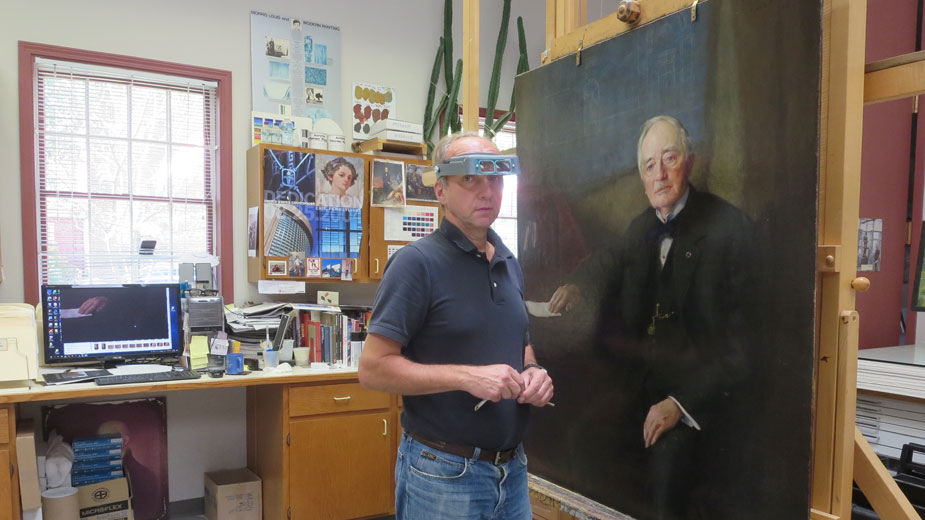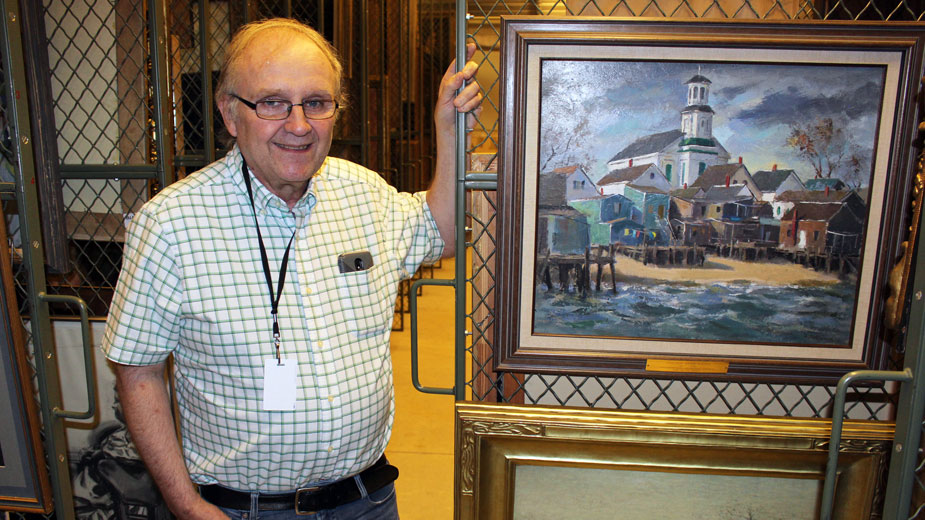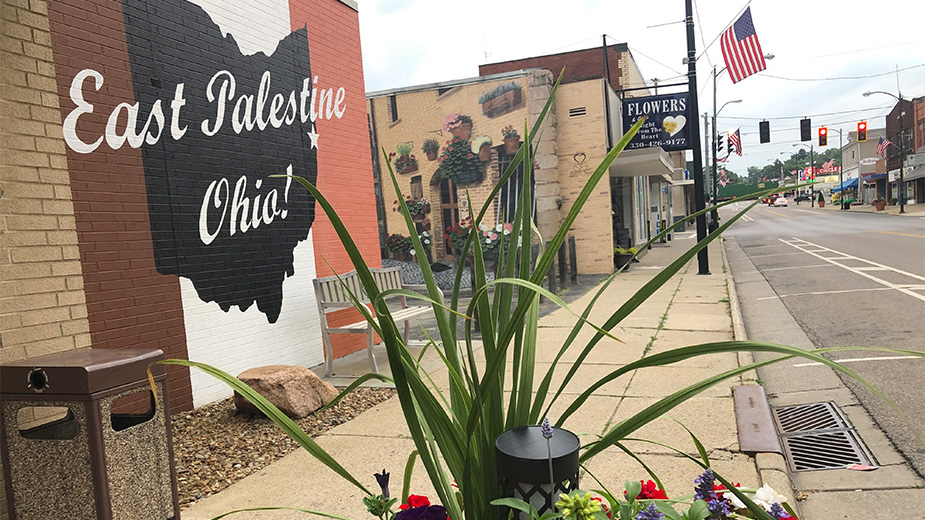Conservation and Archiving Saves Butler’s Treasures
YOUNGSTOWN, Ohio – One day, while walking through the Western collection of The Butler Institute of American Art, which features several smaller paintings, Louis Zona saw something that shocked him.
The director of the museum saw a young man holding one of the works, pointing out its finer details to the girl with him, he says.
“A fellow had lifted one off of the wall and he’s trying to impress his girlfriend with his knowledge of art,” Zona says. “I couldn’t believe what I was seeing.”
In that moment, Zona realized the museum couldn’t afford enough guards to monitor all galleries all the time. While exploring technological solutions, he found Cleveland-based Acuity-vct, which was hired by the Rock and Roll Hall of Fame to design a security system to protect Elvis Presley’s jacket, Zona says.
Acuity designed a system that creates an unseen boundary around each work of art, “and if you break the plane, even with a shadow, it will sound off a voice and our guards are alerted,” he says.
“What a salvation,” he says. “I don’t worry about this anymore.”
From technology and security to conservation and archiving, there is quite a bit that goes on behind the scenes to keep The Butler moving forward. And whether it’s reviving a masterwork or keeping the hands of a would-be savant to himself, these efforts take time and cost money.
The Butler lacks an “enormous fund” from which to draw for art conservation, Zona says. But it’s something that must be done.
“Everything that humans create ultimately turns to dust,” he says. “It’s a rule of the museum to prevent that from happening anytime soon.”
Zona and registrar of the museum and archivist, Pat McCormick, identified a priority list of artwork from The Butler’s 20,000-piece collection. While The Butler budgets about $20,000 annually for conservation work, most of the work done is funded by additional donations through The Butler’s Adopt a Painting program, which was started by its former registrar and current development director, Rebecca Davis.
“One of the things that we’re trying to do is get paintings that were in the inaugural exhibit from 1919 – we’re trying to get them conserved,” McCormick says. “We’ve been really, really lucky. We’ve had most of them done.”
The Butler enlisted the support of McKay Lodge Art Conservation Laboratory in Oberlin, which periodically sends representatives to look over the permanent collection and advise The Butler on what needs work.
McKay Lodge serves national museums and has contracts to work on national monuments in Washington, D.C., as well as national parks. The company specializes in several media, including stone, steel, iron, paper, paint, mosaics and murals.
Stefan Dedecek, painting conservator at McKay Lodge, has worked on art from The Butler since 1998, but the relationship between the two organizations goes back even further, he says. Conservation, he says, is different from restoration, which can interfere with the intent of the original artwork, he says.
“Restoration often recreates or does improper intervention into artwork, and that is not a good way to work on art,” Dedecek says. “In the past, restorers have damaged artwork.”

In an effort to “recover the original artist’s intent, or to preserve it,” art conservation employs materials and techniques that are reversible, he says. Using an infrared camera, Dedecek examines a work to identify any issues. Art conservators are also trained artists, so they can perform “compensation of losses,” he says, essentially addressing paint that has been lost over time by replicating the pigment, types of paint and techniques as close as possible to what the artist used.
“Paintings get damaged or age in different ways. When the painting comes to us, there’s a loss,” he says. “We don’t interfere with the artist’s original intent, and we try to recreate the loss to match the surroundings and will not interrupt the whole sense of the artwork.”
A common issue is the aging of the varnish used on oil paintings, which can take on a yellow, gray or brown hue over time. Conservators don’t clean the varnish; rather they use chemical mixtures to reduce the old varnish without damaging the painting, and then apply a new varnish, he says.
The technique requires an understanding of how certain chemicals interact with the varnish so as not to remove any of the original paint, he says. In addition to his education in art, which includes studying at the Minneapolis College of Art and Design and the University of Delaware’s Winterthur Art Conservation program, Dedecek studied chemistry for two years at Macalester College in St. Paul, Minn.
In June, he completed work on “The Oregon Trail” by Albert Bierstadt. Other than some discoloration from the varnish and previous retouching work that had been done, the painting was “in good shape,” he says.
“After the discolored coating and the disfiguring retouches were removed, I proceeded with filling and compensation of losses and final varnish,” he says.
The process took about three months because Dedecek has other projects ongoing, he says. All work is documented with high-definition photographs taken before, during and after conservation.
Paintings without varnish accumulate dirt and other particulates from the air, Dedecek says. McKay Lodge has developed several ways to address those accumulations, he says, and can even identify whence a painting comes based on the particulates. Artwork from The Butler still contains some of the sulfur leftover from the long-closed steel plants, he says.
“Around the Youngstown area there was a coal-burning region,” he says. “So that affects the surface of the paintings. Sometimes the coal is deposited on a painting and that makes it tough to clean.”
Other variables, such as humidity, can also affect the artwork, he notes. Fluctuating temperatures can cause the paint layer to lift from the canvas and crack.
Until Zona started at The Butler, the museum hadn’t been climate-controlled, McCormick says. “The building was open. It was open to the air.” Although the museum and its storage vaults are now controlled for both temperature and humidity, “things happen,” he says. Last year, when The Butler lent a work by Marsden Hartley to the Metropolitan Museum of Art in New York, the paint layer lifted from the canvas during its journey because of the temperature change, he says.
The condition of a work is included in its record, which McCormick manages in a massive computer database of The Butler’s entire permanent collection, which took years for him and Davis to compile, he says. Records include the description of a work, its title, accession number, date, artist name and birth/death dates, movement and genre. “Basically anything that adds to the provenance of the painting,” he says, which confirms the authenticity of a work.

“Attached to that record are the conservation records,” he says. “I’ve gone in and transcribed all the condition reports for all the paintings over the course of the last 15 years or so.”
Other records include any archival material, such as photographs, articles written about the artist and letters from the artist. “Mister Antonio” by Ernest Ipsen has the most background information of any other work in The Butler collection. After seeing the play of the same title by Booth Tarkington, Joseph Butler Jr., founder of the museum, commissioned the piece be done of the star of the play, Otis Skinner, dressed for his role as Antonio Camaradino.
“I’ve got letters going back and forth between Butler, Skinner and Ipsen that detail pretty much the whole course of the painting,” he says.
While not part of the inaugural show, the painting was special to The Butler, so the museum had it conserved, McCormick says. McKay Lodge did the work for about $8,000, he notes. A donor through the Adopt a Painting program paid to have that painting and two others conserved, he says.
“It was a mess,” McCormick says. “There was a wine glass he was holding. You couldn’t see it. That’s how filthy it was.”
Storage is limited at The Butler, which has six vaults throughout the museum, McCormick says. When he was hired, the museum had about 12,000 works archived, “and I kept on finding things that had not been accounted for over the years,” he says.
“We had this massive Henry Keller collection given to us,” he says. “And I know when I started we had, like, 134 pieces. By the time I was done, it was almost 1,000.”
To keep the art organized – and to ensure he can quickly put together a themed gallery – McCormick identifies and lists as many categories that pertain to each work, such as portraits, seasons, interior scenes, city life and military.
So far, he has more than 90 categories, “which isn’t much, but it does work for what we need,” he says.
“Basically, you’re trying to create as complete a record of an object as you can,” McCormick says. “It’s part of the history of the museum.”
More Butler 100th coverage
- Honoring 100 Years of The Butler (video)
- 3 Minutes With Dr. Louis Zona, Executive Director, Butler Institute of American Art (video)
- Framing History Is Butler’s Art
- Learning Is Lifelong at The Butler Institute of Art
- Business at The Butler Is Its Own Art
- The Butler Paints a Paper Trail to Display Exhibits
Copyright 2024 The Business Journal, Youngstown, Ohio.


